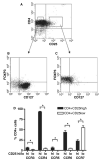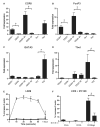Chemokine responsiveness of CD4+ CD25+ regulatory and CD4+ CD25- T cells from atopic and nonatopic donors
- PMID: 19208087
- PMCID: PMC3807784
- DOI: 10.1111/j.1398-9995.2008.01962.x
Chemokine responsiveness of CD4+ CD25+ regulatory and CD4+ CD25- T cells from atopic and nonatopic donors
Abstract
Background: Allergic inflammation is associated with Th2-type T cells, which can be suppressed by CD4+ CD25+ regulatory T cells (Tregs). Both express chemokine receptors (CCR) 4 and CCR8, but the dynamics of expression and effect of atopic status are unknown.
Objective: To examine the expression of chemokine receptors by CD4+ CD25+ and CD4+ CD25- T cells from atopic and nonatopic donors, and document response to allergen stimulation in vitro.
Methods: Chemokine receptor expression was examined by flow cytometry and quantitative PCR of CD4+ CD25hi and CD4+ CD25- T cells from atopics and nonatopics. Responsiveness to chemokines was by actin polymerization. Dynamics of chemokine receptor expression in 6-day allergen-stimulated cultures was analysed by carboxyfluoroscein succinimidyl ester labelling.
Results: CD4+ CD25hi Tregs preferentially expressed CCR3, CCR4, CCR5, CCR6 and CCR8. CD4+ CD25hi Tregs responded to the chemokine ligands for CCR4, CCR6 and CCR8 (CCL17, 22, 20 and 1 respectively), with no differences between atopic and nonatopic donors. Over 6-day allergen stimulation, CD4+ CD25+ T-cells downregulated CCR4 and upregulated CCR7, in contrast to CD4+ CD25- effector cells, which downregulated CCR7 and upregulated CCR4.
Conclusions: CCR4, CCR6 and CCR8 have potential roles in localization of both CD4+ CD25+ regulatory and CD4+ CD25- effector T cells to sites of allergic inflammation. Upregulation of CCR7 and downregulation of CCR4 upon allergen stimulation of Tregs may allow their recirculation from sites of inflammation, in contrast to retention of effector T cells.
Figures




Similar articles
-
Adenoid-derived TH2 cells reactive to allergen and recall antigen express CC chemokine receptor 4.J Allergy Clin Immunol. 2003 Dec;112(6):1155-61. doi: 10.1016/j.jaci.2003.08.029. J Allergy Clin Immunol. 2003. PMID: 14657875
-
Unique chemotactic response profile and specific expression of chemokine receptors CCR4 and CCR8 by CD4(+)CD25(+) regulatory T cells.J Exp Med. 2001 Sep 17;194(6):847-53. doi: 10.1084/jem.194.6.847. J Exp Med. 2001. PMID: 11560999 Free PMC article.
-
Differential expression of Th2 chemokine receptors on T cells from atopic and nonatopic asthmatics in response to Der p 1-pulsed dendritic cells.J Med Assoc Thai. 2010 Jan;93 Suppl 1:S62-70. J Med Assoc Thai. 2010. PMID: 20364559
-
IL-6 alters migration capacity of CD4+Foxp3+ regulatory T cells in systemic lupus erythematosus.Scand J Immunol. 2021 Nov;94(5):e13099. doi: 10.1111/sji.13099. Epub 2021 Sep 8. Scand J Immunol. 2021. PMID: 34940981
-
Recent progress in the development of antagonists to the chemokine receptors CCR3 and CCR4.Expert Opin Drug Discov. 2014 May;9(5):467-83. doi: 10.1517/17460441.2014.897324. Epub 2014 Mar 18. Expert Opin Drug Discov. 2014. PMID: 24641500 Review.
Cited by
-
What does elevated TARC/CCL17 expression tell us about eosinophilic disorders?Semin Immunopathol. 2021 Jun;43(3):439-458. doi: 10.1007/s00281-021-00857-w. Epub 2021 May 19. Semin Immunopathol. 2021. PMID: 34009399 Free PMC article. Review.
-
Interaction of Bifidobacterium bifidum LMG13195 with HT29 cells influences regulatory-T-cell-associated chemokine receptor expression.Appl Environ Microbiol. 2012 Apr;78(8):2850-7. doi: 10.1128/AEM.07581-11. Epub 2012 Feb 17. Appl Environ Microbiol. 2012. PMID: 22344636 Free PMC article.
-
Peanut oral immunotherapy results in increased antigen-induced regulatory T-cell function and hypomethylation of forkhead box protein 3 (FOXP3).J Allergy Clin Immunol. 2014 Feb;133(2):500-10. doi: 10.1016/j.jaci.2013.12.1037. J Allergy Clin Immunol. 2014. PMID: 24636474 Free PMC article. Clinical Trial.
-
CCR8 leads to eosinophil migration and regulates neutrophil migration in murine allergic enteritis.Sci Rep. 2019 Jul 3;9(1):9608. doi: 10.1038/s41598-019-45653-7. Sci Rep. 2019. PMID: 31270368 Free PMC article.
-
Asthma phenotypes.Curr Allergy Asthma Rep. 2009 Nov;9(6):439-45. doi: 10.1007/s11882-009-0065-7. Curr Allergy Asthma Rep. 2009. PMID: 19814916 Free PMC article. Review.
References
-
- Robinson DS, Hamid Q, Ying S, Tsicopoulos A, Barkans J, Bentley AM, et al. Predominant TH2-like bronchoalveolar T-lymphocyte population in atopic asthma. N Engl J Med. 1992;326:298–304. - PubMed
-
- Pease JE, Williams TJ. Chemokines and their receptors in allergic disease. J Allergy Clin Immunol. 2006;118:305–318. - PubMed
-
- Sallusto F, Mackay CR, Lanzavecchia A. Selective expression of the eotaxin receptor CCR3 by human T helper 2 cells. Science. 1997;277:2005–2007. - PubMed
Publication types
MeSH terms
Substances
Grants and funding
LinkOut - more resources
Full Text Sources
Research Materials

